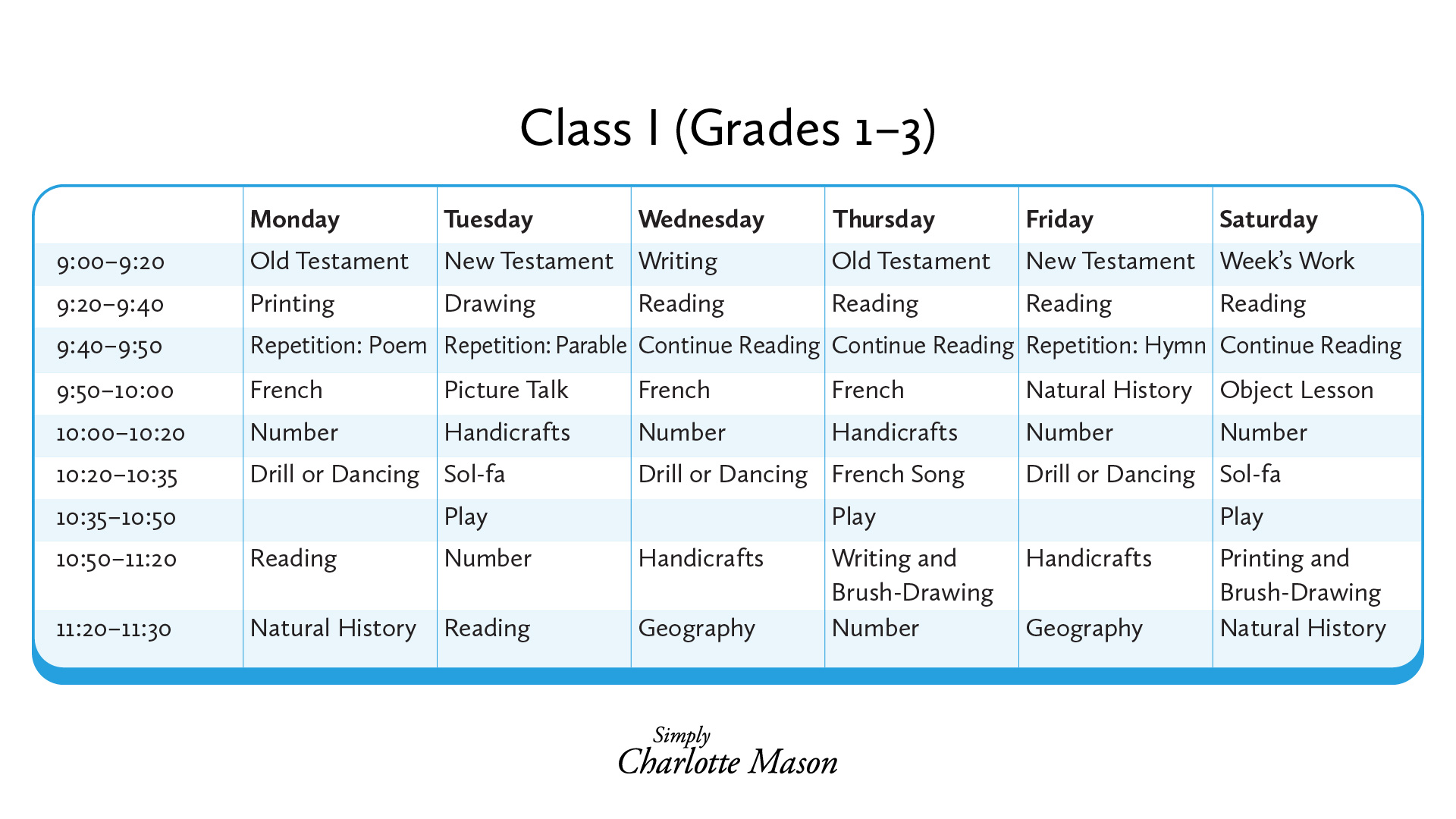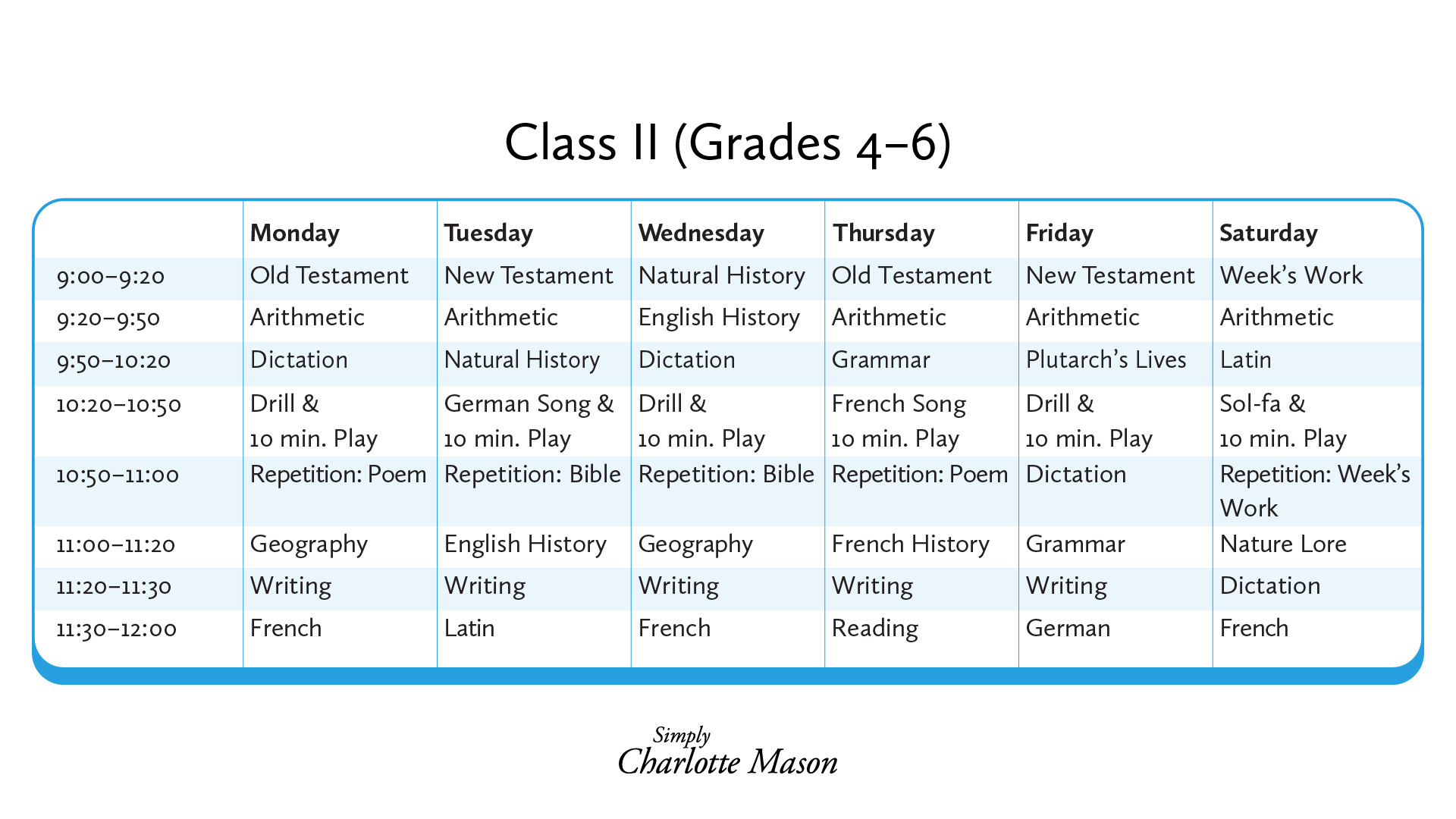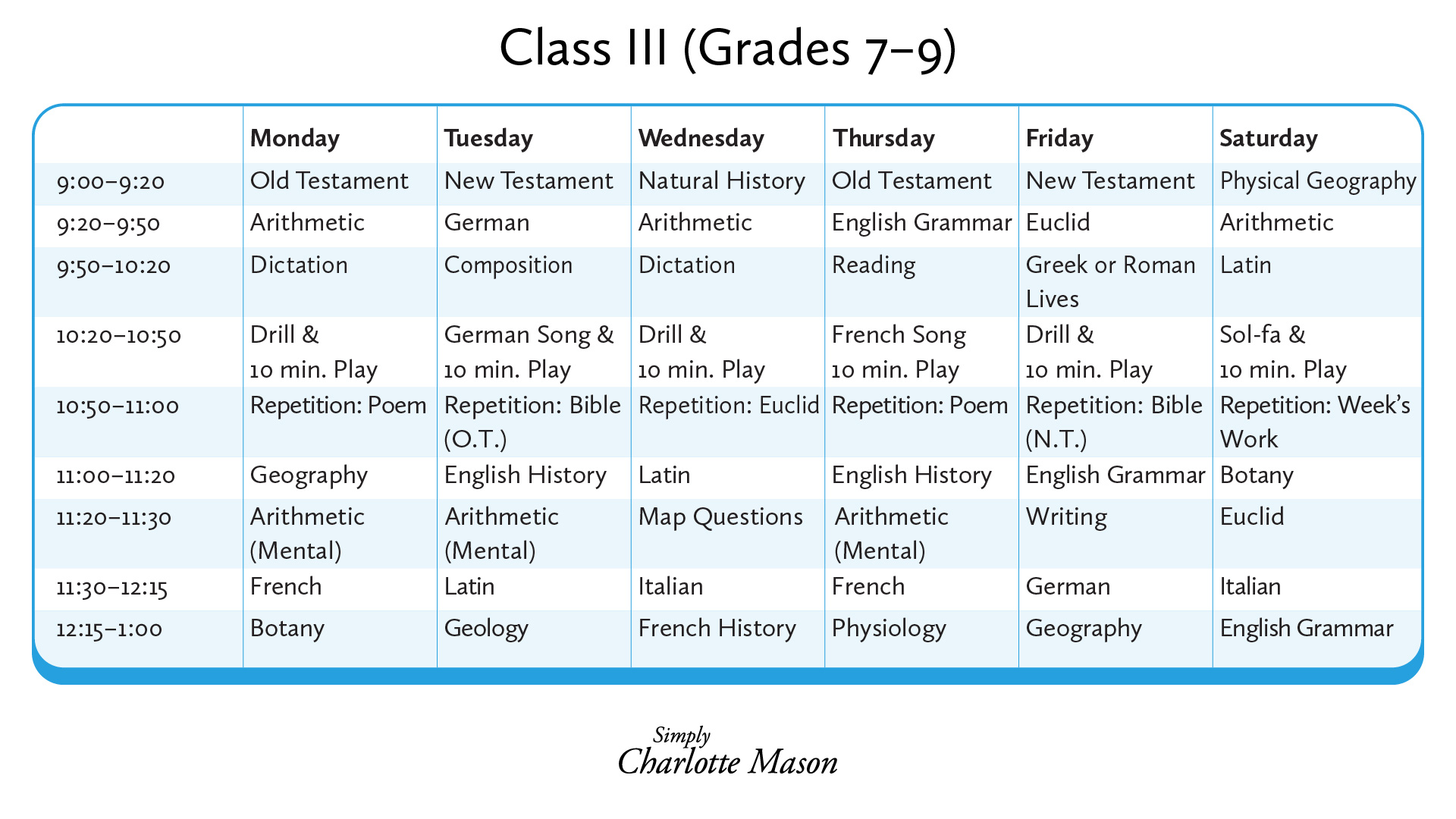60-day returns • free shipping on USA orders $129+
Today I want to talk about something that is a big part of our job as homeschool parents. It’s something that we can spend a lot of time mulling over and discussing and even comparing with our homeschooling friends. And it stands to reason that we put a lot of time and effort into it, because it affects every single day of our children’s education. Today I want to talk about scheduling. We’re going to take a look at Charlotte Mason’s weekly and daily schedules for several grade levels and see what we can learn for our own.
Before we jump in, I want to make one thing very clear: I do not believe that your schedule has to look exactly like Charlotte’s did. So I’m not showing you her schedules in order to tell you to copy them. I am a firm believer in designing your schedule to fit your family best. But I do think we can pull some basic principles from Charlotte’s schedules that will help us to design good schedules for our own families. And that’s what I want to do today. Let’s look at some of Charlotte Mason’s schedules and pull key principles from them that will help us in creating our own.
If you would like to download a copy of the schedules that we will be looking at in this post, we have them available as a free PDF download.


Here is a schedule that Charlotte used for grades 1–3. Perhaps the first thing you’ll notice is that the students were doing schoolwork six days per week. I’m not saying you have to do that; it’s just an interesting observation about that time in history.
The Big Picture
All right, let’s first look at the big picture. Notice which subjects were taught throughout the week. You’ll see that some subjects, such as Reading, were done almost every day; others were done on only two or three days; and some subjects were done only one day a week.
In case you’re wondering, let me clarify a couple of subjects that might look unfamiliar. On all of Charlotte’s schedules that I’ll be showing you today, you’ll see something called “Repetition.” That was a time to study and practice any memory work that had been assigned. Each term her students memorized poems; Bible passages, such as parables; and hymns. You’ll also see “Drill” listed. That refers to Swedish Drill, which was a type of physical exercise. Then “Sol-fa” refers to singing class. They used the sol-fa, or solfège, method. Think Sound of Music: “Do a deer, a female deer.” That’s sol-fa.
Principle 1: A Wide Variety of Subjects
Now, as you look at the subjects listed, you can observe our first principle for scheduling: Schedule a wide variety of subjects during the week. You’ll find more than 15 different subjects on this schedule. And it’s the same for the older grades.


Here is a schedule for grades 4–6. Again, more than 15 different subjects offered during the week. Some of them are different subjects from what was done in grades 1–3, but there is still a wide variety.


And the same holds true for grades 7–9. Some subjects are different, but the wide variety is still there.
Charlotte believed that children need a generous curriculum, covering a wide range of subjects that offer knowledge suitable and fitted for them. Why? Because
“The mind feeds on ideas.” (Preface to the Home Education Series)
and
“It is as true for children as for ourselves that, the wider the range of interests, the more intelligent is the apprehension of each.” (School Education, p. 209)
So as you plan your weekly schedule, make sure that you are including a wide variety of subjects that will give your student a feast of ideas to nourish his mind and heart. I appreciate how Charlotte included the whole spectrum of studies. She covered Bible; many aspects of language arts; several foreign languages; history of different countries and time periods; math, both written and mental; science from books and firsthand nature study; both art instruction and art appreciation; the same for music; handicrafts with a variety of materials; geography, as it tied in with other subjects and on its own; and physical education, teaching the children to dance, to do Swedish Drill, and giving time to play. She truly spread a wide feast, but it wasn’t all on one day. It was spread throughout the week. You can do the same. Give your children a wide variety of subjects spread throughout the week.
Principle 2: Short Lessons
The second principle of scheduling a Charlotte Mason-style education can be found in the timetable column of these sample schedules.


If you look at the timetable for Grades 1–3, you’ll see that lesson times ranged from 10 minutes to 20 minutes, and one time slot is 30 minutes long. Sometimes, also, two time slots would be combined for Swedish Drill or dancing, which makes sense. That combination time slot equaled 30 minutes.
This gives us a key to how we can include a wide variety of subjects without extending schoolwork to 8 hours a day: short lessons. In grades 1–3 that means no more than 20 minutes maximum. You can have one lesson that extends to 30 minutes, and you can take 30 minutes for physical exercise, but the vast majority of the lessons should be no longer than 20 minutes, and some of them only 10 minutes.
Let’s look at the timetable for grades 4–6 and see what “short lessons” means for that level.


Starting at the top, we have 20 minutes, 30 minutes, 30 minutes, another 30 minutes, then 10 minutes, 20 minutes, 10 minutes, and 30 minutes. What guideline can you pull from that schedule for grades 4–6? Most lessons were 30 minutes in length with some only 20 minutes and some only 10. So “short lessons” for grades 4–6 means no lesson longer than 30 minutes.
Okay, let’s look at grades 7–9.


We have a 20-minute lesson first, then 30 minutes, 30 minutes, 30 minutes, 10 minutes, 20 minutes, 10 minutes, oh! 45 minutes, and 45 minutes. So “short lessons” have lengthened as the students have grown older. In grades 7–9, no lesson is longer than 45 minutes, and most lessons are shorter than that.
Keep this principle in mind as you plan your schedule. We often say that a Charlotte Mason education is built on short lessons, but the definition of “short” adjusts as the students grow and develop in their ability to pay full attention for the whole lesson.
Let me throw in here that I have not found daily schedules for high school grades, but we can take the same principle and apply it for lessons at that level: grades 1–3—no lesson longer than 20 minutes; grades 4–6—no lesson longer than 30 minutes; grades 7–9—no lesson longer than 45 minutes. We can keep the maximum at 45 minutes for high school, or we could easily extrapolate that in grades 10–12, no lesson should be longer than 60 minutes. And by those upper grades, we probably wouldn’t call 45 minutes a “short lesson” anymore; but remember that not all lessons were that long. Some time slots in the daily schedule were only 10 minutes, 20 minutes, or 30 minutes. That 45 minutes or an hour is the maximum length at that level.
All right, so far we’ve seen that we should keep a wide variety of subjects throughout the week and we’ve looked at maximum lesson lengths for the various grade levels. Let’s take one more look at Charlotte’s schedules and pull a third principle to help us with our own.
Principle 3: Use Different Parts of the Brain and Body
This time let’s look at each day’s line-up. We’ll start with grades 1–3, and let’s focus on Monday through Wednesday.


Look closely at the subjects listed for Monday and find the ones that would be done with a living book. “Old Testament” would be studied by reading the Living Book and narrating. What else? “Printing” is handwriting. “Repetition” is memory work. “French” is oral. “Number” is an oral math lesson using everyday objects, just as laid out for you in our Charlotte Mason Elementary Arithmetic Series. “Drill or Dancing” is physical exercise. “Reading” would involve reading from a book or learning how to read. “Natural History” would be a read-and-narrate type lesson.
Now look at Tuesday and do the same thing: Where are the lessons that would use a living book? “New Testament” and at the end of the morning is “Reading,” which would involve a book but not necessarily narrating. Do you see how far apart those two lessons are and how much is in between them? The same was true on Monday, wasn’t it?
Let’s look at Wednesday and see if that pattern holds true. It does: “Reading” is second and “Geography” is last in the day.
Now let’s check grades 4–6 and 7–9. To save time, we’ll look at just Monday for each.


In grades 4–6, the subjects that involve reading from a living book on Monday are, first, “Old Testament”; then Arithmetic—that’s not a living book lesson; “Dictation” is usually done with passages from living books; “Drill,” no; memory work, no; “Geography” could involve reading and narrating, as well as map work; “Writing,” no; and “French,” no. Do you see how those living-book subjects are spread out.


If you look at grades 7–9, you see the same thing: “Old Testament,” “Dictation,” “Geography,” and “Botany” are living-book-focused lessons, and they are spread out with other subjects in between.
There’s the third principle: in the daily sequence of lessons, alternate subjects to use different parts of the brain and body. In other words, spread out the lessons that involve reading and narrating from living books, and insert other types of work in between. Use the numbers part of the brain or get up and move around or do a little memory work or another oral lesson or look at a picture or listen to music or sing. You get the idea.
You see, the more we use one part of the brain, the more tired it gets. And as it becomes more tired, it struggles to pay full attention. So if we want to set our students up for success in their studies, we want to not over-tire one part of the brain. Therefore, we schedule the order of the day’s lessons to use different parts of the brain in sequence.
You’ll notice that there is only one 10-minute break written into Charlotte’s schedules each day, called “Play.” How could those students do school work for two-and-a-half or even four hours in the upper grades without several breaks? It was possible because of three things:
1. A wide variety of subjects kept the student’s interest. No two days were the same.
2. Short lessons kept things moving along without getting bogged down.
3. The lessons used different parts of the brain and body in sequence.
That’s how Charlotte’s students were able to keep their focus and get so much done before lunch, and enjoy it.
Our schedules don’t have to look exactly like Charlotte’s, but we can use those same three principles as we plan for our own home schools. Give it a try. I think you and your student will be pleasantly surprised at how enjoyable your schedule can be.
Podcast: Play in new window | Download
Podcast (podcastv): Play in new window | Download
